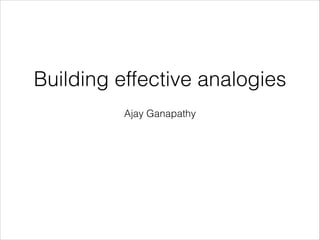
Building good analogies
- 1. Building effective analogies Ajay Ganapathy
- 2. Analogies • According to Schema Theory, people understand new, unfamiliar things in terms of old, familiar things, • They do this by constructing analogies that bridge the gap between the unfamiliar and familiar.
- 3. The limits of analogies • Analogies are a lot like bridges. There are limits to how far they can stretch, and they will collapse under excessive tension. • The more tenuous an analogy, the less weight a learner can place on it before it falls through.
- 4. Native understanding • Bridges are only a pathway to a destination. Similarly, analogies are only a means to an end. In this case, that end is a comprehensive mental model that gives learners a sense of familiarity to the concepts they are learning. • We can refer to this end as a "native understanding"
- 5. Building effective analogies • A bridge is only useful if it can be crossed. • Every analogy has to be custom-built to the user's schema.
- 6. Teachers and designers • Teachers build a separate bridge for each user. Each bridge is built to reach out to the exact schema of the user. Teachers then lead each user across the bridge. • Designers build a single bridge that is accessible to most users. They leave the job of reaching out to each individual user to the teacher. • Designers make the job of the teacher easier.
- 7. Making one analogy for everyone. • Who is the lowest common denominator in your target audience? • What does this person know? • What does this person not know? • What does this person think they know?
